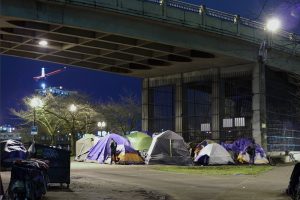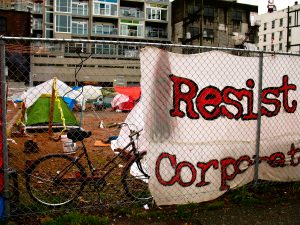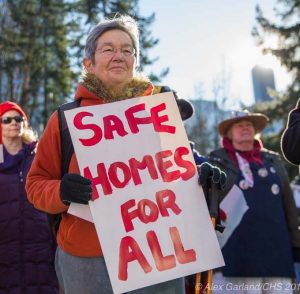Bearings
Hanging out with Homeless Folks in Silicon Valley
Turning Off the Default Settings on "Service" to Begin Structural Change
By Philip Boo Riley
October 2019 Issue

On a warm Friday night in August I sat outdoors with my friend Xavier and three of his buddies, enjoying the pasta dinner I had prepared for the occasion. Xavier is affectionate and talkative, eager to regale us with pieces of his story—emigration from Cuba during the 1980 Mariel boatlift, life as a transgender dancer in San Francisco in the ‘80 and ‘90s, how these days he helps churches distribute food at to the homeless in St. James Park in downtown San Jose. We laughed at our stories, moaned about the current administration’s immigration policy, debated the best places to get Cuban food in the area, fretted over his dog Gigi’s health, and even did a bit of biblical exegesis. (“Matteo” is Xavier’s favorite gospel, and we spent some time on chapter 12’s unclean spirits, trying to relate their persistence to our own attempts at vigilance in the face of demons in our lives.)
Xavier is one of Silicon Valley’s over 9,000 homeless individuals, with 6,000 in San Jose, and another 3,000+ in Santa Clara County. We shared that meal over a utility grate on a patch of grass next to a shopping center parking lot at the edge of downtown San Jose, not far from the railroad tracks alongside which sits the ramshackle collection of tarps, cardboard boxes, pallets, and shopping carts Xavier calls home.
 I’ve had similar meals with other homeless people. One time, it was a Thanksgiving meal in Mama G’s tent under the Guadalupe expressway. Another, I sat around the fire Andrea maintains for cooking and heating water in her elaborate web of tents, tarps, and hoses. (Engineer that she is, she had tapped into a nearby water line for a direct feed to her site. She fixes bikes too!). I’ve found myself sitting on shopping carts with folks whose name I never quite got, and at a street corner near St. James Park with Evelyn, whose vocabulary makes me believe she did in fact earn an MBA at some distant time in her past.
I’ve had similar meals with other homeless people. One time, it was a Thanksgiving meal in Mama G’s tent under the Guadalupe expressway. Another, I sat around the fire Andrea maintains for cooking and heating water in her elaborate web of tents, tarps, and hoses. (Engineer that she is, she had tapped into a nearby water line for a direct feed to her site. She fixes bikes too!). I’ve found myself sitting on shopping carts with folks whose name I never quite got, and at a street corner near St. James Park with Evelyn, whose vocabulary makes me believe she did in fact earn an MBA at some distant time in her past.
My evangelical Christian friend commends me for my “service,” but that word does not do a lot for me. In part what it misses is the cognitive dissonance I experience at locations like the one for this particular meal. As we ate and conversed that night, a constant stream of Teslas queued up at the nearby charging stations, one of dozens of such sites the high tech car company has installed in public places around the Valley to support the growing number of “Teslaholics” in the region. I doubt they even noticed us.
My undergraduates and I have spent a lot of time with homeless individuals in Silicon Valley the past couple of years. We’ve visited shelters and encampments to listen to people’s stories of living on the street and to do a bit of what Dorothy Day calls “corporal works of mercy,” handing out water, snacks, blankets, and socks. We’ve listened to stories of abuse and grief as well as liberation and joy from participants in OnRoute22, a peer-driven support program for formerly and currently homeless women. Young men at CityTeam ministries have shared how they are learning to “work the program” and “walk with God” to overcome the addiction and associated demons that had put them on the streets. We’ve heard from “seniors” my age who, after years on the streets, finally found their way to what the City of San Jose calls “permanent supportive housing.” We’ve also heard from other “seniors” still on the streets about their years of experience as the Valley’s “domestic refugees” (a term I learned from a formerly homeless friend, Robert, now a homeless advocate).
We’ve also heard from people serving homeless individuals in Silicon Valley through various ministries: our local Catholic Workers, who house homeless women and children, staff their “Showers to the People” at encampments, and distribute food to low income families in their neighborhood. “Believers in Christ” founder Pastor Oakie tells us why he makes sure everyone who shows up for their breakfast near city hall also gets a hug. Christian Homeless Alliance Ministry (CHAM) conducts worship in encampments and elsewhere on the streets, trying to bring a message of healing and dignity to people who are frequently pushed to the margins. Founding pastor Scott Wagers calls his ministry “spiritual warfare.” Ganga, part of the Indian diaspora in the area and a follower of the spiritual teacher known as Amma (Mother), explains how serving weekly meals to her homeless neighbors is how she acknowledges the divine she sees within them.
In our debriefs, my students and I struggle to get a handle on these varied conversations. It quickly becomes clear that, when it comes to homelessness, we all have what David Foster Wallace diagnosed in his famous commencement address as “default settings.” Students are moved to want to “give back,” to use the privilege they have been given but not earned to “serve others,” to “help out” where they can.

Frustration is a common response, too. We get frustrated at the Water District authorities, who, at great expense (some estimate over $2 million annually), “sweep” instead of support encampments along the Valley’s rivers and creeks. We are vexed by the homeless themselves, whose resignation to their life on the margins is all too palpable. We groan over elected officials who court high tech companies like Google to move into the city core while neglecting the humanitarian crisis unfolding on our streets. Despair surfaces—not the kind found on the streets, but the kind Dorothy Day described as “[o]ne of the greatest evils of the day” (Loaves and Fishes, 176) when young people say, “What good can one person do?”
There is thought and emotion behind our varied responses, but in the end they don’t quite capture what we have been experiencing in our forays into the Valley’s homeless communities. They are the default settings we have acquired, and it is hard to turn them off.
It is not that nothing is happening “to end homelessness,” as the title of one local study has it. Santa Clara County voters passed a $950 million affordable housing bond in 2016; county and city housing departments partner with local non-profits to open shelters and develop supportive housing units; in 2018 Cisco pledged $50 million over the five years to end homelessness. Countless faith communities have stepped up as well. The local Buddhist Tzu Chi group supports a mobile dental clinic. Hindus partner with Evangelicals to provide meals at encampments throughout the week. Martha’s Kitchen, which has operated across the street from a Catholic parish since the 80’s, offers meals. Downtown mainline Protestant churches provide meals along with clothing, counseling, referrals, showers, and mailboxes through non-profits like Sacred Heart Community Service. Counterparts in the suburbs collaborate on a network of safe places for people living in vehicles to park overnight. Cities across the country have the same sorts of networks of faith-based support for people without stable housing.
 My students are quick to point out that, while faith communities’ efforts and their own version of Day’s works of mercy—granola bars, water, socks are their mainstays—may mitigate individuals’ suffering, they do not seem to be doing anything to reduce homelessness. Indeed, the San Francisco Bay Area, including the Silicon Valley, has the third highest rate of homelessness in the nation. And the number is growing: the recent HUD mandated census showed a 31% increase of homeless individuals over the previous two years (San Jose’s numbers rose 42%). While the fatalism Day lamented emerges, some students try to get a fresh perspective by invoking what Martin Luther King did with the Good Samaritan in his “Beyond Vietnam” address:
My students are quick to point out that, while faith communities’ efforts and their own version of Day’s works of mercy—granola bars, water, socks are their mainstays—may mitigate individuals’ suffering, they do not seem to be doing anything to reduce homelessness. Indeed, the San Francisco Bay Area, including the Silicon Valley, has the third highest rate of homelessness in the nation. And the number is growing: the recent HUD mandated census showed a 31% increase of homeless individuals over the previous two years (San Jose’s numbers rose 42%). While the fatalism Day lamented emerges, some students try to get a fresh perspective by invoking what Martin Luther King did with the Good Samaritan in his “Beyond Vietnam” address:
One day the whole Jericho Road must be transformed so that men and women will not be beaten and robbed as they make their journey through life. True compassion is more than flinging a coin to a beggar; it understands that an edifice which produces beggars needs restructuring.
My students ask: Why aren’t more faith communities doing more of the structural road work around homelessness—calling out forces like social inequality, commodification of housing, criminalization of marginality? We do have congregations doing structural work on other issues—e.g., supporting Black Lives Matter out of longstanding commitment to civil rights; supporting solidarity networks to combat ICE raids out of a commitment to immigrant rights; allying to support co-workers and neighbors advocating for LGBTQ rights. My hunch is that despite long-standing development of a Homeless Bill of Rights across the country, congregations—and my students, and I—have a hard time warming up to the idea that homeless people as homeless people have rights. We see rights as innate, or God-given, and homelessness is, well, an acquired state. Whether chosen or imposed, our default thinking goes, it is a temporary condition in need of a remedy. Those pesky default settings are hard to move past.
So, I return to why I have trouble with the term “service.” It’s not just that it elides the dissonance that I think is crucial to understanding homelessness in Silicon Valley. Service is a transactional term, one that suggests homeless folks are recipients, people in need of what I bring, lacking the resiliency and skills to care for themselves. That, I have learned, is just not so. “We are homeless,” Mama G told me one day, “not helpless.”
But more than misrepresenting all that my homeless friends do to carve out a home for themselves alongside creeks and under freeways, the “service” setting diverts attention from what is happening to me, what I am learning and experiencing—about hospitality when Xavier welcomes me to his spot with a hug, about humor when I joke with Daniel about his contributions to my research (homeless encampments are real “fuckeries,” he explained to me one day, and the term has stuck), about recovery from Simon admitting the 5 days of sobriety he celebrated that week at City Team had been some of the worst of his life, about friendship from Andrea who reminds me the important thing is not the food, clothes or firewood I bring to the encampment but that I remember to come, about committed relationships when Evelyn sets a portion of the meal I brought her aside for her always absent (and imaginary, I wonder) partner. My students and I know we are transformed in ways we never would have imagined before we started hanging out with my homeless friends, and calling this experience “service” does not do it justice.
I need to hang out with my homeless friends more often. And I need to learn from the folks doing ministry with them about how to get past the default settings, to understand what is happening to us in our encounters. Yes, there is service, and that is absolutely important and very much needed. That the number of homeless people who died on the streets in the Valley rose by 164% from 2012 to 2016 is one indicator of that need. But there is also a need to, as David Foster Wallace put it, “really learn how to pay attention” in our encounters with homeless folks. When we do, we may get past our default settings and even begin to embrace the ways in which sharing in the lives of homeless individuals are “not only meaningful, but sacred, on fire with the same force that made the stars: love, fellowship, the mystical oneness of all things deep down.”
Now that, to invoke a Silicon Valley mantra, is a pretty good return on our investment.
Photo Credits:
Featured Image: Elizabeth Drescher, "Silicon Valley Homeless Encampment" (June 25, 2016). Used by permission. All rights reserved.
Image #1: UberXNW, "Homeless Camp" (February 3, 2016). Via Flickr. CC 2.0 license.
Image #2: Sally T. Buck, "Tent City Vancouver" (February 26, 2010). Via Flickr. CC 2.0 license.
Image #3: Backbone Campaign, "Safe Homes for All" (December 5, 2017). Via Flickr. CC 2.0 license.

